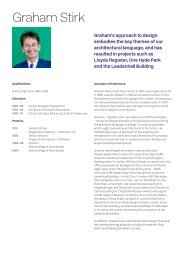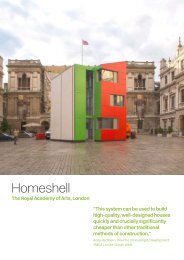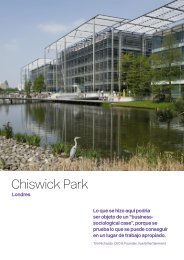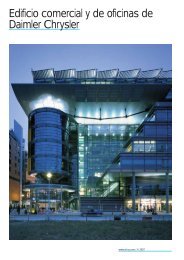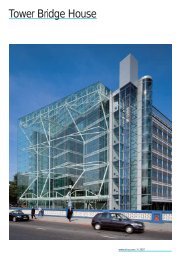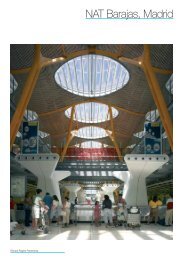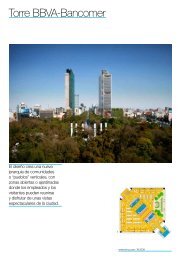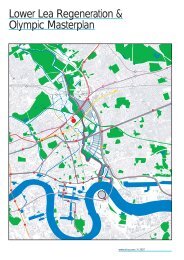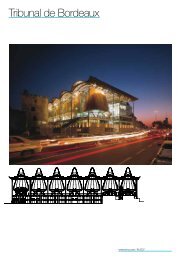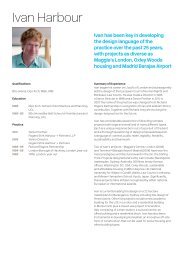Grand Paris Executive Summary (PDF 31MB) - Rogers Stirk Harbour ...
Grand Paris Executive Summary (PDF 31MB) - Rogers Stirk Harbour ...
Grand Paris Executive Summary (PDF 31MB) - Rogers Stirk Harbour ...
Create successful ePaper yourself
Turn your PDF publications into a flip-book with our unique Google optimized e-Paper software.
5 - BUILDING BALANCED COMMUNITIES<br />
<strong>Summary</strong><br />
The social disparities present in metropolitan <strong>Paris</strong><br />
are a major handicap for the region and for France.<br />
Communities in difficulty carry entire districts with<br />
them into spirals of isolation and economic and<br />
psycho-social depression.<br />
Intervention must be taken in a concerted and<br />
coordinated manner on a strategic level, but also<br />
in a practical manner on the ground itself at a local<br />
level.<br />
This is a major challenge which exceeds the<br />
capacity and means of the local municipalities and<br />
the powers of a single communal mayor.<br />
An ambitious national project is required, a “New<br />
Deal”.<br />
It is not a case of displacing communities and<br />
pushing them further from the centre. It is a case of<br />
sensitive integration - “Addition not substitution”<br />
This involves the use of strategies relating to<br />
proximity, social mix and connectivity.<br />
Local economies need to be stimulated and help is<br />
needed to develop local and specialised markets.<br />
The physical isolation of some of the deprived<br />
housing estates can directly generate the feeling of<br />
separation that some communities experience in<br />
relation to the rest of French society and create an<br />
insurmountable gap between these communities<br />
and the wealth that exists elsewhere in the <strong>Paris</strong><br />
region.<br />
We propose a Social Action Plan:<br />
••<br />
Encourage stable communities<br />
••<br />
Promote long-term links at the heart of the<br />
community between local public sector workers<br />
and the inhabitants of the deprived areas<br />
by rewarding those who work with difficult<br />
communities in highly exposed jobs - such as<br />
police officers, teachers, health care workers,<br />
local politicians and civil servants – with an<br />
increase in salary and status.<br />
••<br />
Recognise and support the active members<br />
of these communities and those who are<br />
considered as role models.<br />
••<br />
Encourage support networks<br />
••<br />
Make education a priority through the creation<br />
of exemplary schools that are open to all and<br />
adapted to the real needs of the communities<br />
they serve. Include technical training and the<br />
teaching of appropriate subjects and languages.<br />
••<br />
Reward regular school attendance<br />
••<br />
Ensure good transport access to support links to<br />
jobs, other communities and the city as a whole.<br />
••<br />
Enable access to local jobs, particularly for<br />
young people<br />
••<br />
Develop a community police service using local<br />
police stations. Promote the local recruitment of<br />
police officers and encourage the development<br />
of long-term relationships as well as the creation<br />
of familiarity with the communities they serve.<br />
••<br />
Provide the community with leisure facilities<br />
and places to meet e.g. sports facilities, music<br />
academies, cultural centres and community and<br />
training centres<br />
••<br />
Encourage communication between different<br />
generations<br />
••<br />
Ensure that the local socio-cultural facilities<br />
are affordable and accessible for the local<br />
population<br />
••<br />
Improve the quality of public spaces in the<br />
deprived areas<br />
••<br />
Consult the community on its needs<br />
••<br />
Offer quality architecture in the deprived areas<br />
that expresses respect and the desire to invest<br />
••<br />
Densify the areas in question through a prudent<br />
process of intensification<br />
••<br />
Provide housing that is adapted to demographic<br />
change, including large appartments for large<br />
families and/or families comprising several<br />
generations<br />
••<br />
Provide good night-time lighting and ensure<br />
the safety of the inhabitants when they are out<br />
at night<br />
••<br />
Keep the buildings well-maintained and<br />
modernise them to meet the changing needs of<br />
the community<br />
••<br />
Improve the existing buildings as part of the<br />
changes required by the “Factor 4” energy and<br />
environmental impact initiatives<br />
••<br />
Transform and improve existing buildings - e.g.<br />
housing blocks Vassal and Lacaton in “Bois-le-<br />
Prêtre” tower and the Roland Castro project in<br />
Lorient<br />
••<br />
Put quality private housing next to and in<br />
between other more affordable housing.<br />
••<br />
React quickly to signs of lack of maintenance<br />
and dilapidation<br />
••<br />
Provide examples of opportunities and progress<br />
••<br />
Respect all French citizens whatever their<br />
cultural origins<br />
••<br />
Ensure the citizens of the suburbs are visible<br />
• • Citizenship must evolve to allow the<br />
cohabitation of different feelings of belonging<br />
without these being divisive.<br />
xii <strong>Rogers</strong> <strong>Stirk</strong> <strong>Harbour</strong> + Partners / London School of Economics / Arup<br />
February 2009



